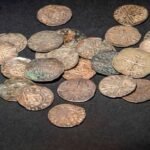The historic coronation stone, central to centuries of royal tradition, remains unharmed after a dramatic security breach in Scotland’s newest national museum.
Security Breach Raises Alarm at Home of Scotland’s Most Sacred Symbol
Authorities in Scotland have arrested a man accused of attempting to smash the protective glass encasing the Stone of Destiny — one of the most culturally and politically significant artifacts in Scottish history.
The incident occurred at the newly reimagined Perth Museum, where the ancient stone has been on public display since its ceremonial return to Perthshire earlier this year. The suspect, identified by police as Arnaud Harixcalde Logan, 35, of Sydney, Australia, was swiftly apprehended and now faces charges of malicious mischief — a Scottish legal term akin to criminal vandalism.
According to local law enforcement, Logan allegedly tried to damage the reinforced glass housing the Stone of Scone, triggering a security response and temporary evacuation of the gallery. No other artifacts were harmed during the incident, and the stone itself remains intact.
A Royal Relic With Centuries of History
The Stone of Destiny, also known as the Stone of Scone, has been used in the coronation of Scottish monarchs for more than 700 years. In 1296, King Edward I of England seized it from Scotland and had it built into the Coronation Chair at Westminster Abbey — a symbolic act of domination over the Scots.
After centuries in London, the stone was formally returned to Scotland in 1996 but remained in Edinburgh Castle until earlier this year, when it was transferred to its ancestral home in Perthshire as part of the revamped £26.5 million Perth Museum redevelopment.
The transfer was supported by Historic Environment Scotland, the UK and Scottish governments, and the Royal Household, in an effort to give the public closer access to what is arguably Scotland’s most contested and emblematic artifact.
“This is a profoundly important object for Scotland’s sense of nationhood,” said a museum spokesperson earlier this year. “Its new home in Perth is both symbolic and practical — a reconnection with the heartland of Scottish kingship.”

Motive Unclear, Investigation Ongoing
As of Friday morning, police have not released further details about Logan’s motives. Officials have ruled out terrorism and say there is no indication of political or nationalist intent at this stage.
The Perth and Kinross Police Division confirmed that Logan was taken into custody shortly after the incident and will appear before the local sheriff court in due course.
“Officers responded promptly to an incident at the Perth Museum involving damage to the display housing the Stone of Destiny,” a spokesperson said. “The artifact was not harmed, and the museum has since reopened to the public. Enquiries are continuing.”
“Malicious Mischief”: A Charge Rooted in Scots Law
The charge against Logan — malicious mischief — is a common law offence in Scotland that predates modern criminal damage statutes. Unlike vandalism charges in England or elsewhere, malicious mischief can apply even if there is no permanent damage, so long as there was intent to cause disruption or fear.
Legal experts say that Logan could face a fine, a custodial sentence, or community service, depending on the severity of the case and the court’s assessment of intent.
Perth Museum’s Reputation Under Scrutiny
The Perth Museum only opened its doors to the public in March 2025, positioning itself as a new national treasure house for Scotland’s deep history and culture. With more than 1,500 objects in its permanent collection and state-of-the-art security systems, the museum was expected to rival the National Museum of Scotland in Edinburgh as a heritage destination.
However, this week’s breach may raise difficult questions for museum leadership — particularly around object security, risk assessment for high-profile artifacts, and public access.
“We’re grateful for the swift action by our security staff and Police Scotland,” said a spokesperson for Culture Perth & Kinross. “Our first concern is always for the safety of our visitors and collections. We are reviewing protocols to ensure we maintain the highest standards going forward.”
National Symbol, Modern Reverberations
The attempted attack on the Stone of Destiny comes at a time when Scotland’s national symbols are under renewed focus — from heated independence debates to growing interest in repatriated cultural objects.
Although the stone’s role today is largely ceremonial — it was used most recently in the coronation of King Charles III in May 2023 — its historical legacy continues to inspire political, cultural, and emotional reactions across the UK and the Scottish diaspora.
For now, the stone sits where it began — in the ancient capital of Perth, unharmed, but freshly reminded of its power to provoke.


















